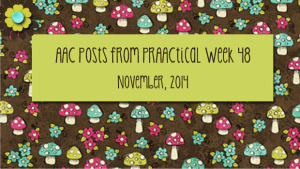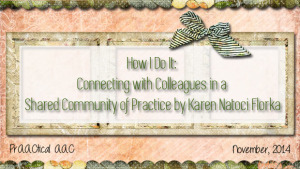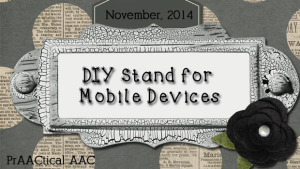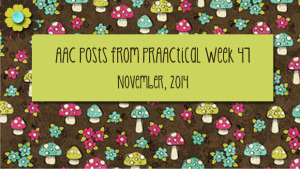December 3, 2014
by Carole Zangari -

Hopes, wishes, and dreams. We wish them for all of our prAACtical friends. Thanks to Keisha and Rylee for sharing theirs and inspiring us to keep reaching. https://www.youtube.com/watch?v=2tbEZJZ0uXU&list=FLxg8rUu_EL2GTES9PUKf-Fw
Filed under: PrAACtical Thinking
Tagged With: dream
December 2, 2014
by Carole Zangari -

Chances are that most of our US-based SLPs have heard about the funding challenges with Medicare. We now have only a few more days to make our voices heard to support clients with AAC needs. If you haven’t already submitted public comment, please take the time to help in these advocacy efforts. Medicare (CMS) currently is reconsidering its National Coverage Decision (NCD) for Speech Generating Devices (SGDs). As part of that process, CMS will allow interested members of the public to submit comments about future Medicare SGD coverage until December 6, 2014. The information that follows was prepared by the Medicare Implementation Team, an ad hoc group of AAC clinicians, researchers, advocates, educators, manufacturers, etc., many of whom worked on the 2001 NCD. FOLLOW THESE 5 SIMPLE STEPS TO SUBMIT A COMMENT TO CMS. 1. Review the 8 PROPOSED COMMENT AREAS below that are critical to include in a revised NCD for... [Read More...]
Filed under: PrAACtical Thinking
Tagged With: advocacy, CMS, funding, Medicare, patient provider communication
December 1, 2014
by Carole Zangari -

We’re all so accustomed to seeing grid-based displays that sometimes we have to make a concerted effort to consider other options. Visual scene displays (VSDs) are a great option for some clients with AAC needs. Here are some resources that may be helpful if you’re considering using them with one of your prAACtical friends. Visual Scene Manual by Drs. Kristy Weissling and David Beukelman Visual Scene Templates for communication books Augmentative Communication News issue on VSD’s Jane Farrall’s SlideShare presentation on VSD’s Visual Scene Display webcast
Filed under: PrAACtical Thinking
Tagged With: Augmentative Communication News, David Beukelman, Jane Farrall, Kristy Weissling, visual scene display, VSD
November 29, 2014
by Carole Zangari -

Sunday: Video of the Week – More on Dealing with Feelings Monday: DIY Stand for Mobile Devices Tuesday: How I D0 It – Connecting with a Shared Community of Practice by Karen Florka Wednesday: Watch It Wednesday – Word Prediction Funnies Thursday: Happy Thanksgiving
Filed under: PrAACtical Thinking
November 27, 2014
by Carole Zangari -

Filed under: PrAACtical Thinking
Tagged With: remember, Thanksgiving
November 26, 2014
by Carole Zangari -

Between the ASHA Convention and preparations for Thanksgiving, we’re dragging. Luckily, comedian Lee Ridley (“The Lost Voice Guy”) is ready to give us a smile.
Filed under: PrAACtical Thinking
Tagged With: humor, Lee Ridley, word prediction
November 25, 2014
by Carole Zangari -

I had the pleasure of meeting Karen Natoci Florka last month when I visited Michigan and am delighted that she was willing to introduce us to the Shared Community of Practice from the team at The Communication Matrix. Karen is an SLP who has served students aged 3-26 with various physical, sensory and intellectual challenges at Wing Lake Developmental Center (Detroit area) since 2001. She is a part time lecturer at Wayne State University where she teaches a course entitled “Communication Acquisition and Educational Interventions for Students with Moderate to Severe Impairments.” She is part of the Communication Matrix Charter group. Click on the image below to learn more. The Communication Matrix is growing into a Shared Community of Practice! I remember the first few weeks in my new job at a wonderful, magical, school for children with complex communication needs. It was time for my first evaluation. These amazing students were challenging! They seemed... [Read More...]
Filed under: PrAACtical Thinking
Tagged With: collaboration, Communication Matrix, Community of Practice, connection, How I Do It, Karen Natoci Florka
November 24, 2014
by Carole Zangari -

Simple Inexpensive Easy Three reasons to love this easy-to-make stand for the iPad or Tablet. Take a look and click through for instructions.
Filed under: PrAACtical Thinking
Tagged With: DIY, iPad, mount, stand, tablet
November 22, 2014
by Carole Zangari -

Sunday: Video of the Week – Aided Language Input in Conversation Tuesday: Teach Me Tuesday: Communicator Wednesday: Watch it Wednesday – I Am Able Thursday: Throwback Thursday: Teaching Core Vocabulary
Filed under: PrAACtical Thinking
November 20, 2014
by Carole Zangari -

While I’m soaking up AAC knowledge at the ASHA Convention, here’s a post from the past. :::::::::::::::::::::::::::::::::::::::::::::::::::::::: Among the many changes that the AAC field has experienced in the last decade is the notion that core vocabulary is (or should be) an integral part of any AAC system. We grew to understand the limitations of AAC supports that consist primarily of nouns and descriptors, realizing that those kinds of communication displays restricted our clients to requesting and labeling. Our field realized the inadequacy of providing only prestored messages (e.g., limited the client’s ability to communicate anything novel, not flexible enough to meet most communication needs, etc.). In essence, we realized that without core vocabulary, we were imposing a ceiling on language development. We’re thrilled to see so many communication boards, books, SGDs, and AAC apps reflect this knowledge. Having tools with the appropriate vocabulary is a big step in the... [Read More...]
Filed under: PrAACtical Thinking
Tagged With: core language, core vocabulary









